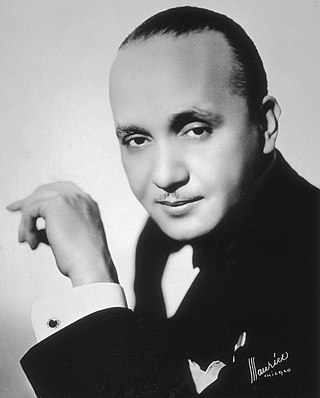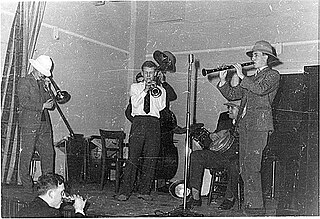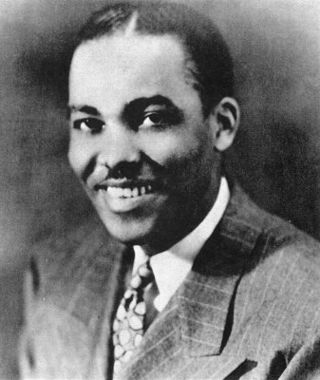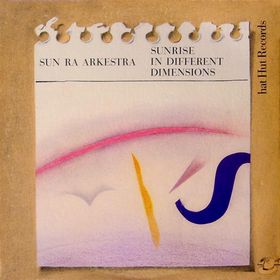"King Porter Stomp" is a jazz standard by pianist Jelly Roll Morton, first recorded in 1923. The composition is considered to be important in the development of jazz. [1] It became a hit during the swing era, when it was recorded by Benny Goodman.
According to Jelly Roll Morton, the tune was composed in 1906 and was the first "stomp" in the history of jazz. [2] Morton first recorded the number in 1923 as a piano solo, but did not file a copyright on the tune until 1924. That year, Morton recorded a duet version with Joe "King" Oliver on cornet. Morton said that he had actually written the tune almost 20 years earlier, and that it was named after his friend and fellow pianist Porter King. According to S. Brun Campbell, Morton was having difficulty finishing the piece and sent it to Scott Joplin who was living in St. Louis for help. [3]
On July 1, 1935, Benny Goodman and his orchestra recorded Fletcher Henderson's arrangement of the number, backed with "Sometimes I'm Happy". It was released July 31 as Victor 25090, and became a sizeable hit and a standard of the big band era. Goodman's recording featured the well known trumpeter of the day Bunny Berigan. Fletcher Henderson had recorded his own arrangement several times with his own band during the 1920s and early 1930s. Harry James recorded a version in 1939 on Brunswick 8366. Other big bands also recorded the tune, as did more traditional jazz groups.
Late 1960s "space-age" bandleader Pat Williams recorded the song on his 1968 Verve LP Shades of Today.
In 1975, Gil Evans and his orchestra arranged a new cover in There Comes a Time album, with Tony Williams, David Sanborn and George Adams among others.
The American jazz trio Air recorded the tune for their 1979 album Air Lore .
{{cite book}}: CS1 maint: location missing publisher (link)
Ferdinand Joseph LaMothe, known professionally as Jelly Roll Morton, was an American ragtime and jazz pianist, bandleader, and composer of Louisiana Creole descent. Morton was jazz's first arranger, proving that a genre rooted in improvisation could retain its essential characteristics when notated. His composition "Jelly Roll Blues", published in 1915, was one of the first published jazz compositions. He also claimed to have invented the genre.

Benjamin David Goodman was an American clarinetist and bandleader known as the "King of Swing".
Swing music is a style of jazz that developed in the United States during the late 1920s and early '30s. It became nationally popular from the mid-1930s. The name derived from its emphasis on the off-beat, or nominally weaker beat. Swing bands usually featured soloists who would improvise on the melody over the arrangement. The danceable swing style of big bands and bandleaders such as Benny Goodman was the dominant form of American popular music from 1935 to 1946, known as the swing era, when people were dancing the Lindy Hop. The verb "to swing" is also used as a term of praise for playing that has a strong groove or drive. Musicians of the swing era include Duke Ellington, Benny Goodman, Count Basie, Cab Calloway, Jimmy Dorsey, Tommy Dorsey, Woody Herman, Harry James, Lionel Hampton, Glenn Miller, Artie Shaw and Django Reinhardt.

James Fletcher Hamilton Henderson was an American pianist, bandleader, arranger and composer, important in the development of big band jazz and swing music. He was one of the most prolific black musical arrangers and, along with Duke Ellington, is considered one of the most influential arrangers and bandleaders in jazz history. Henderson's influence was vast. He helped bridge the gap between the Dixieland and the swing eras. He was often known as "Smack" Henderson.
Jazz standards are musical compositions that are an important part of the musical repertoire of jazz musicians, in that they are widely known, performed, and recorded by jazz musicians, and widely known by listeners. There is no definitive list of jazz standards, and the list of songs deemed to be standards changes over time. Songs included in major fake book publications and jazz reference works offer a rough guide to which songs are considered standards.
The swing era was the period (1933–1947) when big band swing music was the most popular music in the United States. Though this was its most popular period, the music had actually been around since the late 1920s and early 1930s, being played by black bands led by such artists as Duke Ellington, Jimmie Lunceford, Bennie Moten, Cab Calloway, Earl Hines, and Fletcher Henderson, and white bands from the 1920s led by the likes of Jean Goldkette, Russ Morgan and Isham Jones. An early milestone in the era was from "the King of Swing" Benny Goodman's performance at the Palomar Ballroom in Los Angeles on August 21, 1935, bringing the music to the rest of the country. The 1930s also became the era of other great soloists: the tenor saxophonists Coleman Hawkins, Ben Webster and Lester Young; the alto saxophonists Benny Carter and Johnny Hodges; the drummers Chick Webb, Gene Krupa, Jo Jones and Sid Catlett; the pianists Fats Waller and Teddy Wilson; the trumpeters Louis Armstrong, Roy Eldridge, Bunny Berigan, and Rex Stewart.

Horace W. Henderson, the younger brother of Fletcher Henderson, was an American jazz pianist, organist, arranger, and bandleader.

Trad jazz, short for "traditional jazz", is a form of jazz in the United States and Britain that flourished from the 1930s to 1960s, based on the earlier New Orleans Dixieland jazz style. Prominent trad jazz musicians such as Chris Barber, Acker Bilk, Kenny Ball, Ken Colyer and Monty Sunshine performed a populist repertoire which also included jazz versions of pop songs and nursery rhymes.

Joseph Copeland Garland was an American jazz saxophonist, composer, and arranger, best known for writing "In the Mood".
In music and jazz harmony, the Stomp progression is an eight-bar chord progression named for its use in the "stomp" section of the composition "King Porter Stomp" (1923) by Jelly Roll Morton. The composition was later arranged by Fletcher Henderson, adding greater emphasis on the Trio section, containing a highly similar harmonic loop to that found in the Stomp section. It was one of the most popular tunes of the swing era, and the Stomp progression was often used.

Sunrise in Different Dimensions is a 1980 live jazz album by the Sun Ra Arkestra documenting a concert at the Gasthof Morhen in Willisau, Switzerland from February 24, 1980 which was released on the hat Hut label. The album intermingles a variety of Sun Ra originals with covers of jazz standards.

"Farewell Blues" is a 1922 jazz standard written by Paul Mares, Leon Roppolo and Elmer Schoebel.

The period from the end of the First World War until the start of the Depression in 1929 is known as the "Jazz Age". Jazz had become popular music in America, although older generations considered the music immoral and threatening to cultural values. Dances such as the Charleston and the Black Bottom were very popular during the period, and jazz bands typically consisted of seven to twelve musicians. Important orchestras in New York were led by Fletcher Henderson, Paul Whiteman and Duke Ellington. Many New Orleans jazzmen had moved to Chicago during the late 1910s in search of employment; among others, the New Orleans Rhythm Kings, King Oliver's Creole Jazz Band and Jelly Roll Morton recorded in the city. However, Chicago's importance as a center of jazz music started to diminish toward the end of the 1920s in favor of New York.
Walter Melrose was a music publisher and lyricist in the 1920s and 1930s.

The Smithsonian Collection of Classic Jazz is a six-LP box set released in 1973 by the Smithsonian Institution. Compiled by jazz critic, scholar, and historian Martin Williams, the album included tracks from over a dozen record labels spanning several decades and genres of American jazz, from ragtime and big band to post-bop and free jazz.
Christopher Columbus is an American jazz song composed by Chu Berry with lyrics by Andy Razaf. Pianist Fats Waller turned the tune into a 1936 novelty hit which was subsequently recorded by numerous other artists and became a jazz standard. Jimmy Mundy wrote the lead into a medley with "Sing, Sing, Sing" for Benny Goodman.

A Study in Frustration: The Fletcher Henderson Story is a box set compilation surveying studio recordings of the Fletcher Henderson Orchestra from 1923 to 1938, released in 1961 on Columbia Records, CXK 85470. It initially appeared as a four-album set produced by Frank Driggs and assembled by John Hammond, both of whom also wrote the liner notes. The set was part of a Thesaurus of Classic Jazz series on Columbia which included King of the Delta Blues Singers also worked on by Hammond and Driggs and released in 1961, the first album reissue of songs by blues legend Robert Johnson.

Clarinet Marmalade, later Clarinet Marmalade Blues, is a 1918 dixieland jazz standard composed by Larry Shields and Henry Ragas of the Original Dixieland Jass Band. It is played in the key of F major. It was recorded by Fletcher Henderson in 1926 and Frankie Trumbauer in 1927.